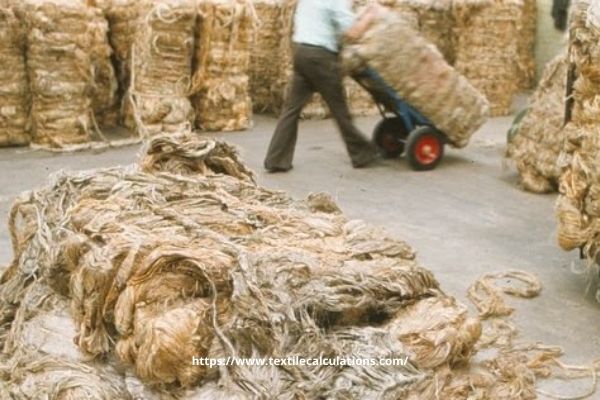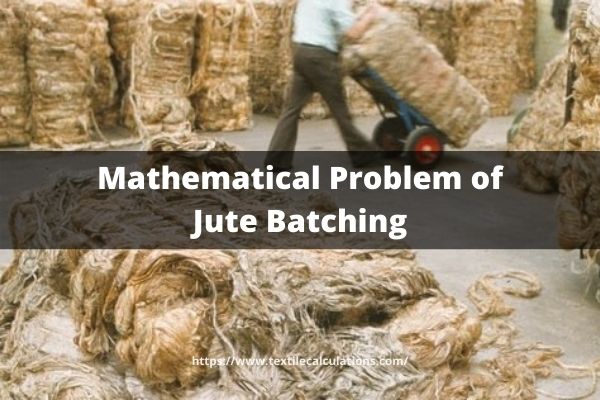Jute Batching:
If the jute fiber is taken from the bale and passed directly over the spinning machinery, then the yarn which is made from it is weak and irregular and the amount of water in processing is high. In order to produce an acceptable yarn it has been customary from the earliest days of jute manufacture on an industrial scale to condition the fiber for jute spinning by adding oil and water to it – this operation is known as batching. In this article, we will know about the mathematical problem of jute batching.

Mathematical Problem of Jute Batching
Problem :1
What is the delivered count of the sliver under the following condition?
- Raw jute feeding rate (lb/min) = 27
- Emulsion flow (gal/hr) = 32
- S.G. of emulsion = 0.97
- Length of sliver in a roll (yd) = 450
- Time to from a roll(min) = 7.2
Solution:
………………………..32 ×9.2
Emulsion flow = ……..…… = 5.2 lb/min
……………………………60
Total delivery = 27.0+5.2
= 32.2 lb/min
………………………….450
Delivery speed = ……….. = 62.5 yd/min
..…………………………7.2
…………………….32.2×100
Sliver count = ………………. = 51.5 lb/100yd. (ANS)
………………………..62.5
You may like also: Mathematical Problem of Jute Drawing
Problem: 2
If leaders were used how many leader rolls per hour would be needed if the draft is12?
Solution:
…………………….62.5
Feed speed = ……….. = 5.21yd/min
………………………12
Length on a roll = 450 yd
Therefore,
………………………….450
1 roll will last = ……………. = 86.5 min
………………………….5.21
But two leaders are always required, so
…………………………………….2×60
Rolls per running hour = ………… = 1.39 (ANS)
……………………………………..86.5
Objects of Jute Batching
- Assistance fibre motion freely during processing.
- Larn expected dampness in addition to flexibility.
- Take hardness in addition to the stiffness of jute fibers.
- To intermix the batch element effectively.
- Cut down loss due to wastage.
- Command in addition to cut down yarn terms.
Factors Considered for Batch Selection
- Cost of raw cloth.
- Availability in addition to the duration of stock jute.
- Physical properties in addition to the character of jute fibers.
- Quality of yarn.
- Cost of production.
- Machine used during processing.
- The demand of the customer.

